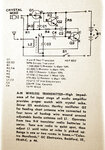Eshal
Advanced Member level 1

- Joined
- Aug 29, 2012
- Messages
- 470
- Helped
- 16
- Reputation
- 32
- Reaction score
- 15
- Trophy points
- 1,298
- Location
- Nowhere :)
- Activity points
- 5,149
Nice information. I don't know anything about lambda, but I know lambda is a wavelength.Lambda ? it is wave distance . it will given from the formula3*10^8)/F it is according to the meter . an example : consider you want transmit 27 MHZ , sine wave . it's lambda , is 3*10^8/27*10^6=11 meter
So , if you use an image reflected antenna ( lambda/4 ) it's dimension will be 11/4 =2.75 meter . it will be just a wire . but if you use dipole antenna , lambda/2 you will have two wire . first one is ground and the other one is out put . distance of your antenna will be 11/2=5.5 meter . it means two wire with 2.75 meter size . or each other kind of antenna ! but for transmitters at high powers , and frequency of HF band , most of the time , most reasonable choice is lambda/2 antenna .
I have read. But we didn't cover this topic yet in our course.( didn't you have telecommunications in university ? or perhaps didn't you read any book regarding this issue ever ?)
All resistors used in zsolt1's circuit.Which resistor you are referring to ?
OK. Thanks for this.High level transmitters will have supplies higher than that . for example a transmitter with power of 200 watt is high level . or for instance , a transmitter with power of 800 KW . it is high level and it's design steps are completely different .
Can you tell me how to determine the range of the transmitter by calculations. I want to determine the range of zsolt1's circuit.
Thank you goldsmith








